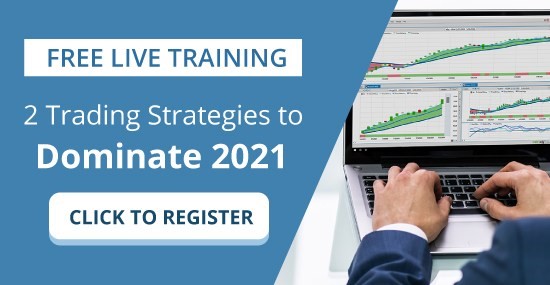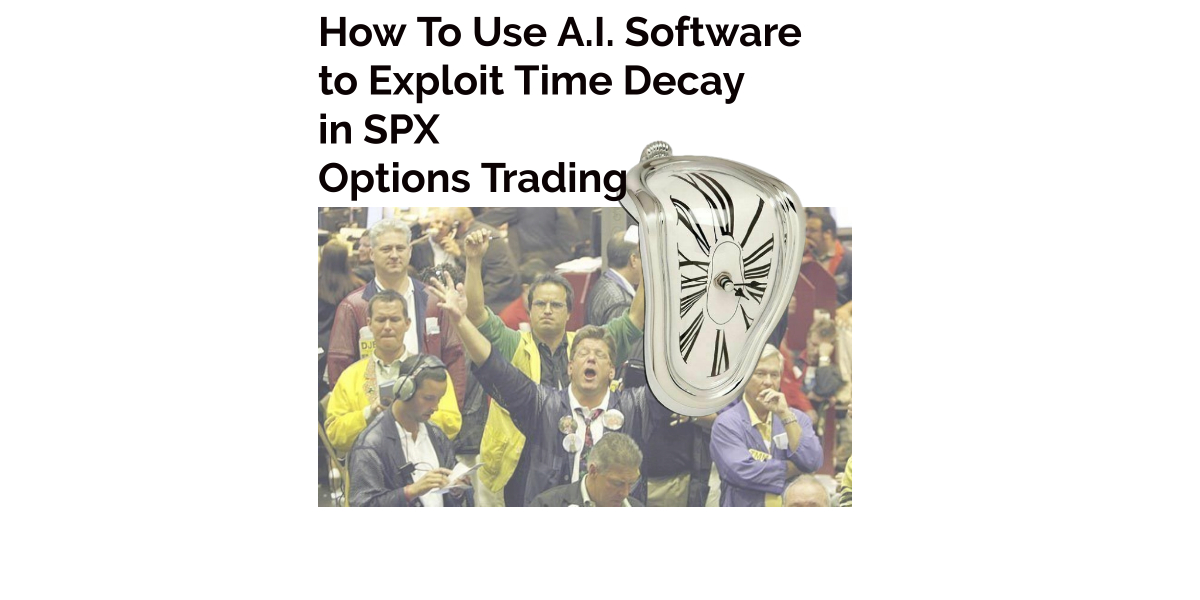
I always ask traders who are new to Options Trading to think about the insurance business so that they can better understand the mechanics of Options trading.
Every insurance contract is identical to an Options contract.
Any insurance contract will insure you for a specific amount of coverage, for a specific amount of time. In exchange for this protection, you will be required to pay a premium payment to the insurer. If you understand these basic elements, you will quickly understand that Options trading is quite literally “price insurance.”
All Options are instruments that are only good for a specified period of time. This is referred to as the duration.
They are deteriorating assets for this reason. All things being equal, an Option will be worth less tomorrow than it is today, simply because it is closer to the expiration date.
There are seven factors that determine the price that you pay for an Option.
Of these seven, six have known values, and there is no uncertainty about their input values into an Option pricing model.
But the seventh variable—volatility—is at best a guesstimate, and for this reason, it is the most important factor in determining the price of an Option.
- The current price of the underlying – known
- Strike price – known
- Type of Option (Call or Put) – known
- Time to the expiration of the Option – known
- Risk-free interest rate – known
- Dividends on the underlying – known
- Volatility – unknown
These are the facts of all Options pricing models. With this being the case what becomes vitally important is being able to accurately forecast the future volatility.
- Options prices depend entirely on the estimated future volatility of the underlying asset. Trading volatility, therefore, is a vital skillset of understanding which permits the development of strategies which enhance the probabilities of success.
Enter Stage Right Artificial Intelligence and the Volatility Index
The Cboe Volatility Index (VIX) is a real time market index for the relative strength of near-term price changes of the S&P 500 index (SPX). It is derived from the prices of SPX index Options with near-term expiration dates, it generates a 30-day forward projection of volatility. Traders use it as a means of anticipating how quickly prices change, The VIX is often seen as a way to gauge sentiment, and in particular the degree of fear among market participants. You can read our more detailed explanation of the VIX here.
But for Options traders the VIX tells you whether the only unknown variable in the Options pricing model is inflating or deflating Option prices.
Let’s look at a few charts to demonstrate how artificial intelligence assists Options traders with understanding what future volatility is projected to be.
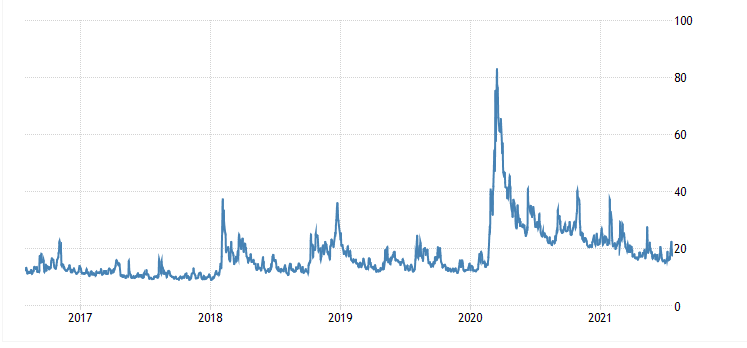
This chart is a 5-year chart of the Volatility Index (VIX). It only provides us a broad-based idea of what is considered high and what is considered low. What is needed for Options traders is a means to determine whether volatility is expected to increase or decrease in the future. If we had an effective way of forecasting volatility, we would know whether we should be considering buying or selling Options.
The key to the Vantagepoint analysis is the predictive blue line. The slope and general direction of the blue line determines the trend forecast for the market.
The Vantagepoint Software has three separate modules which create a forecast for a trader. They are the predictive blue line, the Neural Net (machine learning), and the Intermarket Analysis.

The predictive blue line also acts as value zone where in uptrends traders try to purchase the asset at or below the blue line.
Traders use the predictive blue line in helping to determine both the value zone as well as the trend direction.
VantagePoint traders can analyze the predictive blue line on a short term, medium term, or longer-term horizon to establish a trend forecast. They can also use these forecasts to acquire single and/or double confirmation.
To understand and appreciate how powerful this indicator is, let me show it to you without any of the daily price bars on the chart.
- The slope of the predictive blue line determines the very short-term trend.
- On the following graphic, monitor that you would want to buy Options when the slope of the blue line is going up.
Here is the artificial intelligence forecast of the VIX from March 19, 2020, to July 29, 2021.
The VIX is also referred to as the fear gauge. Whenever the S&P 500 suffers a massive decline, the VIX rises sharply; conversely, when the S&P 500 is rising, in a healthy market the VIX will be trending lower.
Traders often go to the VIX just to measure how much FEAR is in the market compared to previous periods of anxiety.
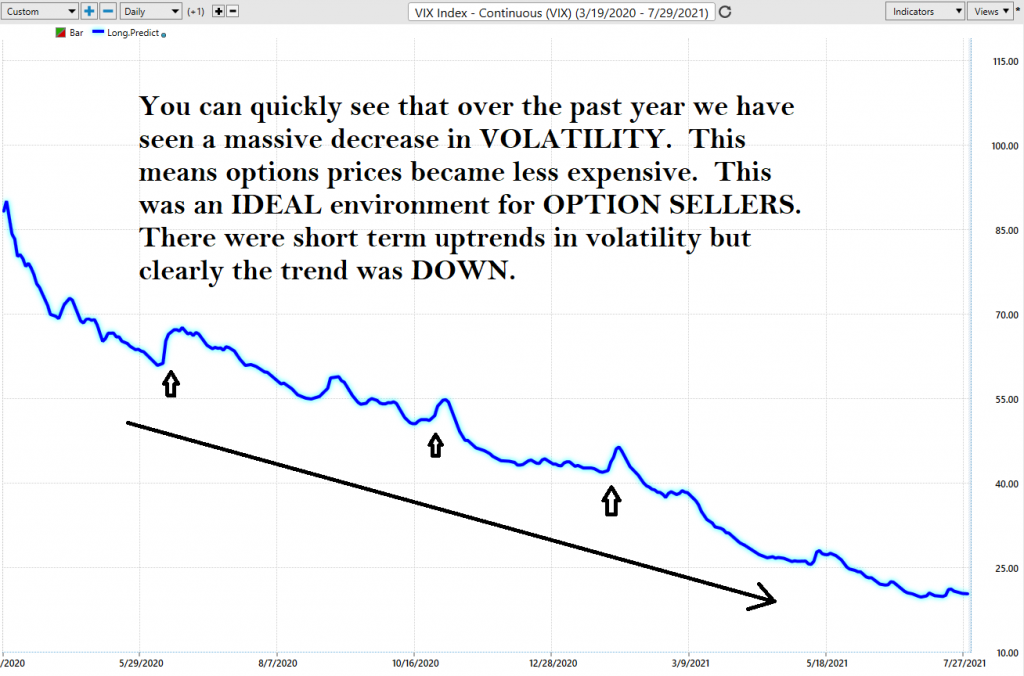
Over the past year, Option sellers had a massive advantage because of the declining volatility in the market. This does not mean that all Option sellers WON. It means that pricing of Options led to lower Options premiums. So, if you bought Options, either puts or calls, even if you were correct on the trend direction the market had to work so much more to make up for what was lost in Option premium volatility (vega).
The most fundamental principle of trading is buying low and selling high, and trading Options is no different. Option traders will typically sell (or write) Options when volatility is high and expected to decline. Likewise, when implied volatility is low, Options traders will buy Options with the expectations that fear, and volatility will increase in the markets.
Smart traders develop strategies and tactics to exploit the deteriorating nature of all Options contracts.
A buyer of an Option has rights. To receive those rights, they will have to pay a premium payment to the Option seller. In other words, an Options buyer is paying money for “price insurance.” They want to have to right to buy or sell the asset at a pre-determined price, between now and a specified date, in exchange for a premium they receive today.
A seller (creator) of an Option has obligations. They will be required to offset their position or fulfill their obligation if the market works against them. Option Sellers are quite literally like insurance companies. They take your Options premium and are agreeing to make good on your demands.
You can read more about other Options strategies which you can exploit with A.I. by studying these articles on covered calls, selling puts, selling strangles and iron condors.
Before going any further with Options strategies stop and think about how large insurance companies are. They are literally in the probabilities game offering buyers “peace of mind” in exchange for “premium payments.” They are not trying to win on every contract they write. Instead, they are focused on managing risk on every contract they enter into.
To be successful trading Options over the long term this must be your mindset as well. You need to understand what risk management means. When you know how to protect yourself using Options that is when you open yourself up to another world of possibilities.
Over the past year Options buyers could have been correct on the trend but if they were wrong on their volatility forecast, they most likely still lost money.
When you begin to comprehend this reality, you start understanding that trading can be much more than a binary affair. Many traders think of UP as good and down as bad. When you learn Options trading, you start to think more about price ranges where you are exposed to minimal risk, or better yet, how to eliminate risk entirely from a trade by using Options in your trading arsenal.
Savvy traders quickly learn they can simultaneously buy and sell Options contracts creating very unique and distinctive risk reward scenarios that often can put probabilities overwhelmingly in their favor.
What this means is, you can be the insurer and collect Option premiums in your account. However, before you do so, you need to understand that should the market move adversely, you will be required to either close out your position with a corresponding loss or fulfill the obligation that you created.
Selling Options for income is one of the few strategies where you can be completely wrong about the direction of the market and still win. This is because an Option is a deteriorating asset, and the premium will deteriorate exponentially the closer the Option is to the expiration date.
Many traders when they understand this focus only on trading the front month Options going into expiration, primarily to collect the premium on the Options contract. The graphic below shows how the Options decay becomes exponential in the last 30 days of the Option contracts existence.
By no means does this mean it is not risky. A seller of a put Option is obligating themselves to own the stock at the agreed upon strike price between now and the expiration date.
A Seller of a Call Option is obligating themselves to be short the market at an agreed upon price.
This time decay of Option premium is best shown through the following chart:
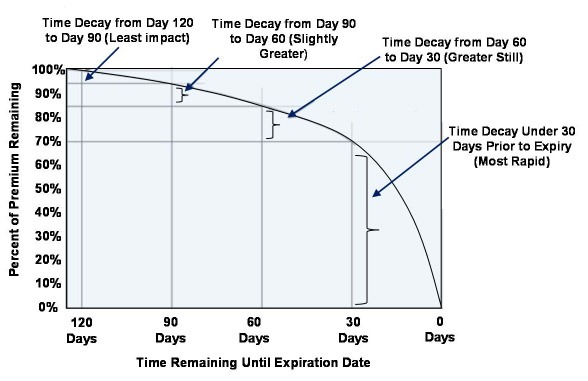
Many years ago, it took me about 6 months of serious study to understand Options trading.
What I wish I had at the time was an artificial intelligence forecast of volatility. Why? Because the volatility of an asset is what determines how much you pay or receive for an Options contract. If you get that wrong, your trading is going to be very stressful.
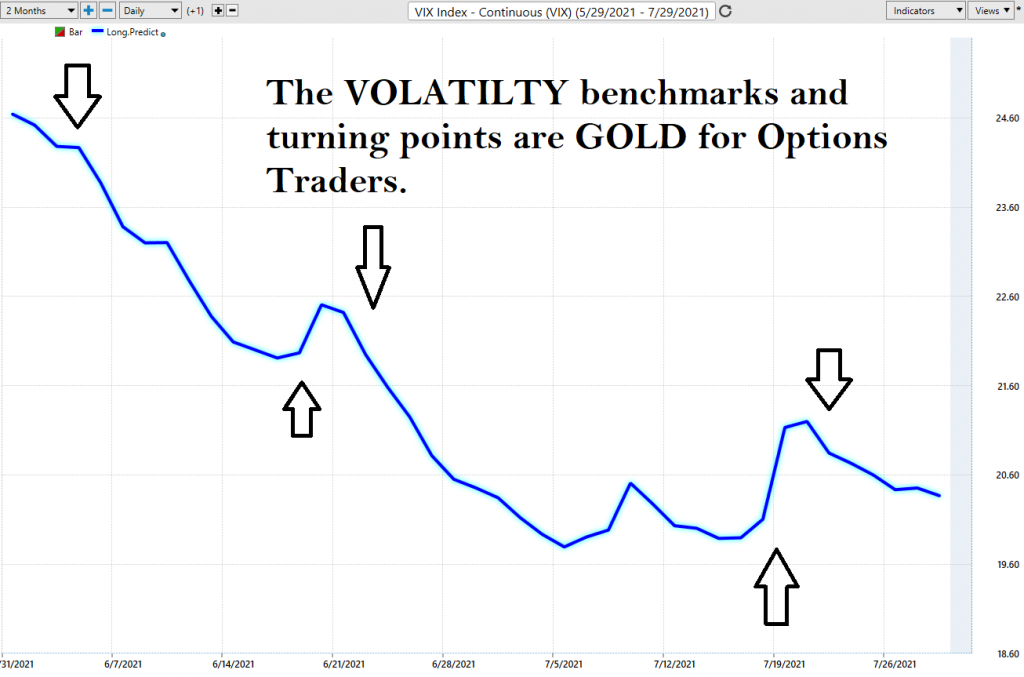
Power Traders study the VIX A.I. forecast to determine whether they see opportunities to buy, sell, or stand aside from the Options markets. This forecast incorporates artificial intelligence and machine learning to put tremendous power and opportunity at an Options trader’s fingertips.
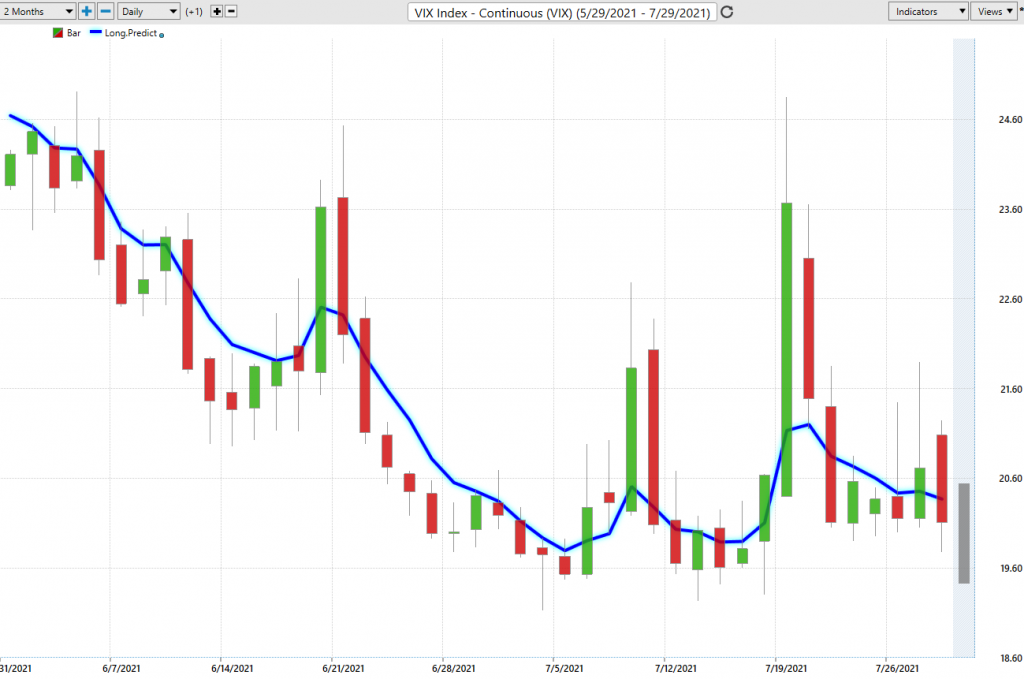
Artificial intelligence is so powerful because it learns what doesn’t work, remembers it, and then focuses on other paths to find a solution. This is the Feedback Loop that is responsible for building the fortunes of every successful trader I know.
If you think about this question, you will begin to appreciate that ai applies mistake prevention to discover what is true and workable. Artificial Intelligence applies the mistake prevention as a continual process 24 hours a day, 365 days a year towards whatever problem it is looking to solve.
That should get you excited because it is a game-changer.
It sounds very elementary and obvious. But overlooking the obvious things often hurt a traders’ portfolio.
The basics are regularly overlooked by inexperienced traders.
If you are trading Options, you have to be obsessed with the VOLATILTY of the market.
The beauty of neural networks, artificial intelligence and machine learning is that it is fundamentally focused on pattern recognition to determine the best move forward. When these technologies flash a change in forecast it is newsworthy. We often do not understand why something is occurring but that does not mean that we cannot take advantage of it.
The chart above illustrates how VantagePoint traders read the volatility to anticipate tomorrow’s headline news.
Price is the only thing that will make you RICH or POOR. Volatility is the prime determinant of how much you pay or receive for the Options you are trading.
Artificial intelligence has decimated humans at Poker, Jeopardy, Go! and Chess. Why should trading be any different?
Intrigued? Visit with us and check out the A.I. at our Next Live Training.
Discover why artificial intelligence is the solution professional traders go-to for less risk, more rewards, and guaranteed peace of mind.
It’s not magic. It’s machine learning.
Make it count.
IMPORTANT NOTICE!
THERE IS SUBSTANTIAL RISK OF LOSS ASSOCIATED WITH TRADING. ONLY RISK CAPITAL SHOULD BE USED TO TRADE. TRADING STOCKS, FUTURES, OPTIONS, FOREX, AND ETFs IS NOT SUITABLE FOR EVERYONE.
DISCLAIMER: STOCKS, FUTURES, OPTIONS, ETFs AND CURRENCY TRADING ALL HAVE LARGE POTENTIAL REWARDS, BUT THEY ALSO HAVE LARGE POTENTIAL RISK. YOU MUST BE AWARE OF THE RISKS AND BE WILLING TO ACCEPT THEM IN ORDER TO INVEST IN THESE MARKETS. DON’T TRADE WITH MONEY YOU CAN’T AFFORD TO LOSE. THIS ARTICLE AND WEBSITE IS NEITHER A SOLICITATION NOR AN OFFER TO BUY/SELL FUTURES, OPTIONS, STOCKS, OR CURRENCIES. NO REPRESENTATION IS BEING MADE THAT ANY ACCOUNT WILL OR IS LIKELY TO ACHIEVE PROFITS OR LOSSES SIMILAR TO THOSE DISCUSSED ON THIS ARTICLE OR WEBSITE. THE PAST PERFORMANCE OF ANY TRADING SYSTEM OR METHODOLOGY IS NOT NECESSARILY INDICATIVE OF FUTURE RESULTS. CFTC RULE 4.41 – HYPOTHETICAL OR SIMULATED PERFORMANCE RESULTS HAVE CERTAIN LIMITATIONS. UNLIKE AN ACTUAL PERFORMANCE RECORD, SIMULATED RESULTS DO NOT REPRESENT ACTUAL TRADING. ALSO, SINCE THE TRADES HAVE NOT BEEN EXECUTED, THE RESULTS MAY HAVE UNDER-OR-OVER COMPENSATED FOR THE IMPACT, IF ANY, OF CERTAIN MARKET FACTORS, SUCH AS LACK OF LIQUIDITY. SIMULATED TRADING PROGRAMS IN GENERAL ARE ALSO SUBJECT TO THE FACT THAT THEY ARE DESIGNED WITH THE BENEFIT OF HINDSIGHT. NO REPRESENTATION IS BEING MADE THAT ANY ACCOUNT WILL OR IS LIKELY TO ACHIEVE PROFIT OR LOSSES SIMILAR TO THOSE SHOWN.


